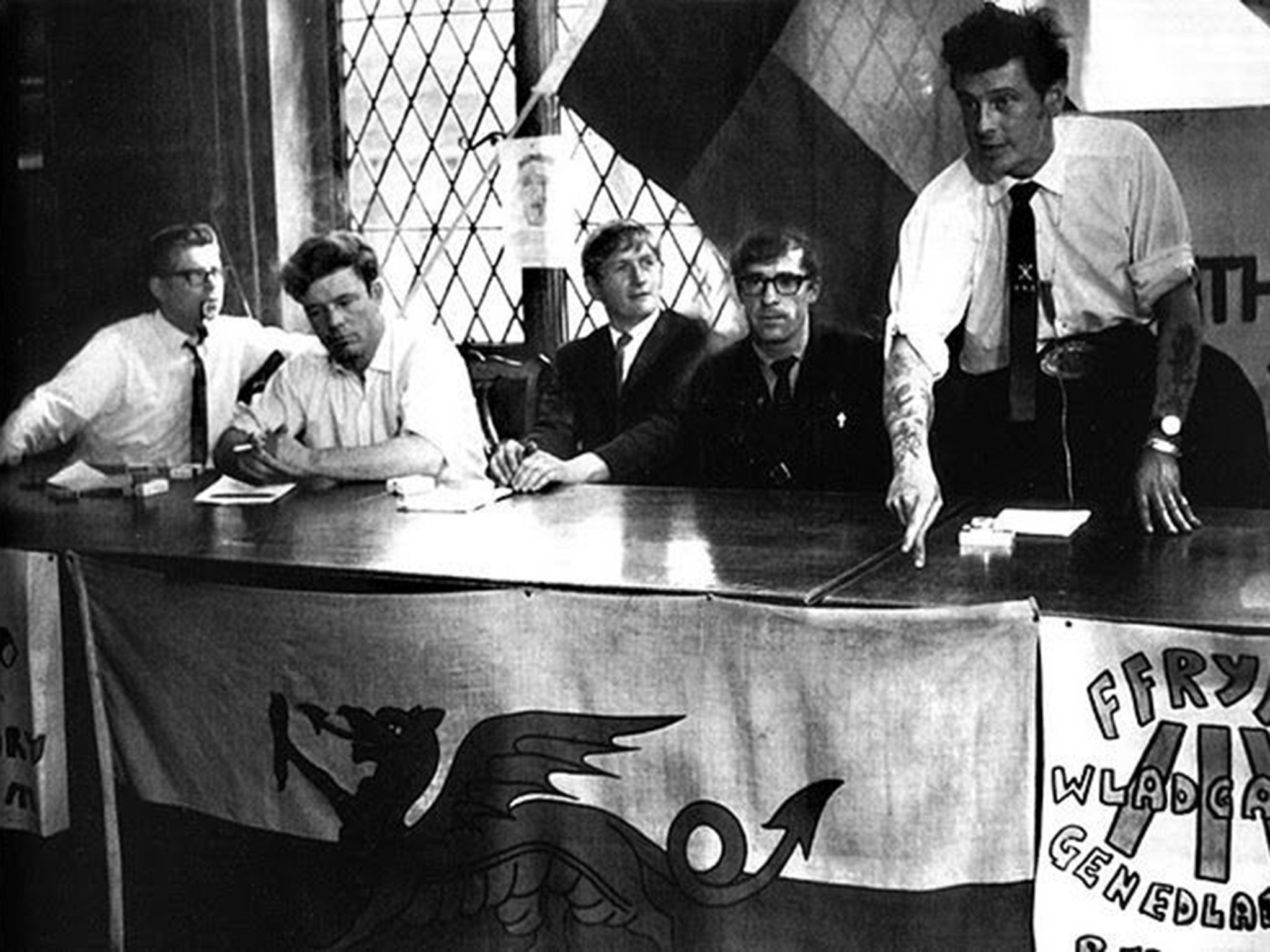Dafydd Burns: Member of the Free Wales Army who walked free from court in 1969 after being kept in solitary confinement
The trial was about free speech, said John Mortimer: 'They had done no acts of violence or sabotage'

John Mortimer QC used to tell an anecdote about the Free Wales Army trial in which he was a defence counsel. The 1969 trial had been a black comedy, and Mortimer’s tale is worth retelling following the death of Dafydd Burns, one of the nine men in the dock.
Mortimer was present throughout the 11-week trial, in which FWA leaders were said among other things to have planned to hire a helicopter to drop farmyard manure on the Prince of Wales’s investiture at Caernarfon Castle, and possessed arms and gelignite. The subsequent creator of Rumpole of the Bailey said of the proceedings, which were held in Swansea: “All the police on the case were called Dai this and Dai that. There was Dai Notebooks, Dai Exhibits, Dai Scene-of-Crime, etc. When I wanted to cross-examine the officer who claimed to have found explosives, I was told, ‘Oh, you’ll be wanting Dai Plant’.”
Mortimer, who died in 2009, had told the Swansea jury that the trial was about the free expression of views. “They had done no acts of violence or sabotage. If one of these men was in a position of there being evidence against him of being connected with any such thing, to be sure the proper charges would have been levelled long ago.”
The charges were principally under the Public Order Act, in connection with parading as a paramilitary group. Two of the nine men were sentenced to 15 months’ jail, another to nine months’, and three were given suspended sentences. Burns had earlier walked free (no case to answer), and two were found not guilty. All had been kept in solitary confinement after dawn arrests in mid-February 1969 until the trial began in mid-April. It ended, remarkably, on 1 July – the very day of Prince Charles’s investiture at Caernarfon.
Burns was born in Bridgend, from a very poor background. He ended up at Bryn y Don borstal near Cardiff. He joined the Army, becoming a sergeant in the Corps of Royal Engineers. After leaving the military he was a lorry driver and eventually became a local authority transport manager. He took up further education at Coleg Harlech, studying Welsh and history, and then at Aberystwyth University. He was commissioned by a Christian organisation in America to carry out extensive research into the architecture of chapels throughout Wales.
Burns – known to his friends as Dafydd y Dug (pronounced “Deeg”, and meaning Duke) – supported the FWA when it emerged in the mid-1960s in protest at the flooding of the Tryweryn valley near Bala, to provide water for Liverpool industry. The 70 villagers of Capel Celyn were evicted and their homes submerged after the government backed a parliamentary private bill, sponsored by Liverpool city council. Controversially, the subsequent act meant that planning consent was not required. All opposition was steamrollered.
Bombings did occur in Wales over Tryweryn, and the investiture, though they were carried out by groups unconnected to the FWA. But its propaganda aims were highly successful. Wearing home-made khaki uniforms, and usually sharing a war-souvenir Sten gun and a Mauser pistol that belonged in a museum, they staged “mountain manoeuvres” for camera crews who arrived in droves from London and the Continent. Two thousand troops were at the ready, it was reported.
Leading protagonists, notably a charismatic west Wales horse-breeder named Cayo Evans, met countless journalists in country pubs such as the Pheasant Inn near Lampeter to outline, as much drink flowed, plans to counter more valleys being flooded, and halt the investiture. Police and security services were being hugely embarrassed.
And why, politicians demanded, were there were still no arrests over the bombings? In 1968 Scotland Yard sent a top Special Branch unit into Wales and arrests of FWA members began early the following year.
Journalists were the bulk of the prosecution witnesses at the trial. But an absentee from the witness box was John Summers, who wrote for the Daily Telegraph about the FWA in the 1960s. Summers was exposed as a police informant by John Humphries, a former editor of the Western Mail, in his 2008 book Freedom Fighters: Wales’s Forgotten War (University of Wales Press).
Humphries established that Summers had been supplying police with a stream of detailed accounts of conversations, names, addresses, descriptions as well as photographs, for several years. Humphries’ book recounts that John Gower QC, another defence counsel, told the jury that Summers, who died in 2008, “flitted to and fro like a phantom” over the proceedings.
Burns paid a price: his mother died while he was in custody during the Swansea trial. He was escorted to the funeral at Glyntaff crematorium in Pontypridd by two policemen; he was handcuffed to one of them. His plea to be uncuffed during the service was refused.
After the trial Burns continued working in road haulage, though often experienced difficulties gaining the kind of employment he wanted. He became a Welsh language tutor in the evenings - including giving regular classes at his beloved Otley Arms pub in Treforrest.
David Burns (Dafydd y Dug), Welsh language teacher and activist: born Bridgend 14 January 1940; died Trefforest 11 September 2014.
Subscribe to Independent Premium to bookmark this article
Want to bookmark your favourite articles and stories to read or reference later? Start your Independent Premium subscription today.

Join our commenting forum
Join thought-provoking conversations, follow other Independent readers and see their replies